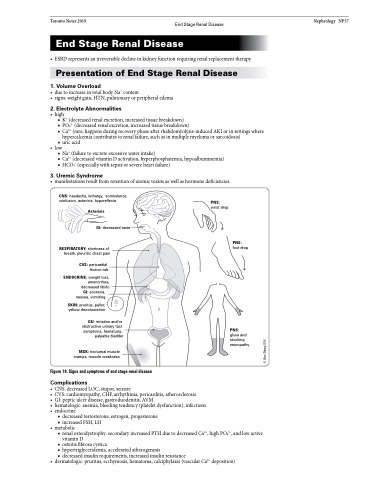Page 737 - TNFlipTest
P. 737
Toronto Notes 2019 End Stage Renal Disease Nephrology NP37 End Stage Renal Disease
• ESRDrepresentsanirreversibledeclineinkidneyfunctionrequiringrenalreplacementtherapy
Presentation of End Stage Renal Disease
1 . Volume Overload
• due to increase in total body Na+ content
• signs:weightgain,HTN,pulmonaryorperipheraledema
2 . Electrolyte Abnormalities
• high
■ K+ (decreased renal excretion, increased tissue breakdown)
■ PO43- (decreased renal excretion, increased tissue breakdown)
■ Ca2+ (rare; happens during recovery phase after rhabdomyolysis-induced AKI or in settings where
hypercalcemia contributes to renal failure, such as in multiple myeloma or sarcoidosis) ■ uric acid
• low
■ Na+ (failure to excrete excessive water intake)
■ Ca2+ (decreased vitamin D activation, hyperphosphatemia, hypoalbuminemia) ■ HCO3- (especially with sepsis or severe heart failure)
3 . Uremic Syndrome
• manifestationsresultfromretentionofuremictoxinsaswellashormonedeficiencies
CNS: headache, lethargy, somnolence, confusion, asterixis, hyporeflexia
Asterixis
GI: decreased taste
RESPIRATORY: shortness of breath, pleuritic chest pain
CVS: pericardial friction rub
ENDOCRINE: weight loss, amenorrhea, decreased libido
GI: anorexia, nausea, vomiting
SKIN: pruritus, pallor, yellow discolouration
GU: irritative and/or obstructive urinary tact symptoms, hematuria,
palpable bladder
MSK: nocturnal muscle cramps, muscle weakness
Figure 19. Signs and symptoms of end stage renal disease
Complications
PNS:
wrist drop
PNS:
foot drop
PNS:
glove and stocking neuropathy
• CNS:decreasedLOC,stupor,seizure
• CVS: cardiomyopathy, CHF, arrhythmia, pericarditis, atherosclerosis
• GI:pepticulcerdisease,gastroduodenitis,AVM
• hematologic:anemia,bleedingtendency(plateletdysfunction),infections • endocrine
■ decreased testosterone, estrogen, progesterone
■ increased FSH, LH • metabolic
■ renal osteodystrophy: secondary increased PTH due to decreased Ca2+, high PO43-, and low active vitamin D
■ osteitis fibrosa cystica
■ hypertriglyceridemia, accelerated atherogenesis
■ decreased insulin requirements, increased insulin resistance
• dermatologic: pruritus, ecchymosis, hematoma, calciphylaxis (vascular Ca2+ deposition)
© Alice Zheng 2014


